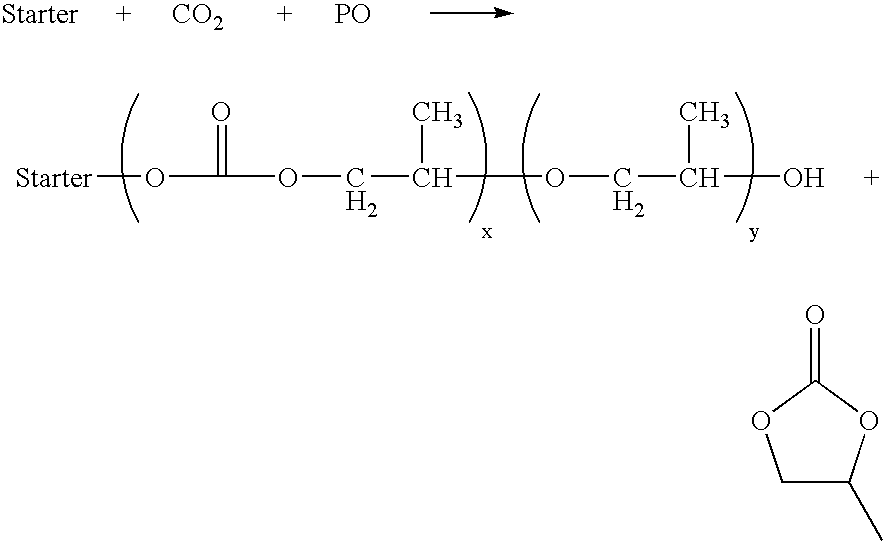Polyether carbonate polyols made via double metal cyanide (DMC) catalysis
a technology of polyether carbonate and catalysis catalyst, which is applied in the field of polyether carbonate polyols, can solve the problems of cyclic alkylene carbonate by-products, limited success of these studies, and high cost, and achieve the effect of lowering the level of cyclic carbonates
- Summary
- Abstract
- Description
- Claims
- Application Information
AI Technical Summary
Benefits of technology
Problems solved by technology
Method used
Image
Examples
examples
[0027]The present invention is further illustrated, but is not to be limited, by the following examples. In the examples below, polyether carbonate polyols were typically made as follows: a glycerine-initiated polyoxypropylated triol of nominal 700 Da molecular weight (350 g) and the amount of substantially non-crystalline DMC catalyst, made according to U.S. Pat. No. 5,482,908 listed below in the tables were charged to a polyol reactor. The mixture was heated to 130° C. and vacuum stripped with nitrogen for 20 minutes. Immediately before the reaction started, the pressure was reduced to 0.1 psia and 53 g of propylene oxide (PO) was added to activate the catalyst. After the pressure reached one-half of the initial pressure, the reactor temperature was set as given below in the tables (90 to 150° C.) and carbon dioxide was fed into the reactor using a pressure regulator. Propylene oxide (1098 g) was fed over the time given below in the tables. At the end of the PO feed, the reaction ...
examples c1 to 6
[0028]As can be appreciated by reference to Table I below, the viscosity values for the 3,000 Da triols are comparable with the all PO triol made in example C1. However, where significant amounts of CO2 are added to the polyol, the viscosity tends to be increases. Because CO2 can reduce the activity of the DMC catalysts, more catalyst is needed to maintain the same activity.
examples 7 to 19
[0029]Table II below demonstrates the effects of temperature, catalyst amount and carbon dioxide pressure on carbon dioxide incorporation into polyethers.
TABLE ITable ICatalystCO2ReactionPO feedHMW tailViscosityEx. No.(ppm)(psia)Temp. (° C.)time (hrs)Unsaturation(100k)OH #(cSt)PDIC1508010030.0033600355.234062.252505013030.0047161576211.113508013030.004814056.86851.1245012013030.004815255.67661.1751008010030.003928253.511901.2661008010060.00361535410711.18
TABLE IIReactionPO feedLinearCyclicCyclictemp.CO2CatalysttimecarbonatecarbonateCarbonate / ViscosityEx. No.(° C.)(psia)(ppm)RPM(hrs)(%)(%)Total (%)OH #(cSt)PDI790403020062.350.000.055.58161.18890403060022.960.072.355.710341.499904020020021.230.000.055.87061.1310904020060064.230.6513.355.7732111008010060069.341.5214.053.210681.0612100100100600515.402.1112.0545.84268131207010040033.761.2024.255.96711.04141304020060065.690.9113.852.88401.03151307010040031.870.209.755.56721.1516130701004003.51.600.1910.655.86051.0917150403020020.520.000.0...
PUM
| Property | Measurement | Unit |
|---|---|---|
| Temperature | aaaaa | aaaaa |
| Temperature | aaaaa | aaaaa |
| Temperature | aaaaa | aaaaa |
Abstract
Description
Claims
Application Information
 Login to View More
Login to View More - R&D
- Intellectual Property
- Life Sciences
- Materials
- Tech Scout
- Unparalleled Data Quality
- Higher Quality Content
- 60% Fewer Hallucinations
Browse by: Latest US Patents, China's latest patents, Technical Efficacy Thesaurus, Application Domain, Technology Topic, Popular Technical Reports.
© 2025 PatSnap. All rights reserved.Legal|Privacy policy|Modern Slavery Act Transparency Statement|Sitemap|About US| Contact US: help@patsnap.com

